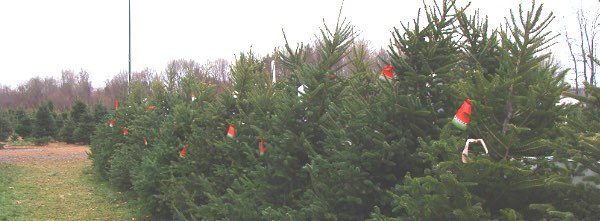- By Lindsey Hadlock
- Around Town
 Print
Print 
As families continue their search for the perfect Christmas tree this season, three Cornell University experts offer advice for picking and preserving holiday trees. The three work closely with New York Christmas tree producers
Brian Eshenaur a plant pathologist, specializing in plant diagnostics, is a senior extension associate with the New York State Integrated Pest Management program. He suggests - sight, touch and smell - when picking your tree.
"Look for a tree with a good solid-green color. Needle yellowing or a slight brown speckled color could lead to early needle drop," he says. "Don't be afraid to handle and bend the branches and shoots. Avoid a tree if green needles come off in your hand or the shoots crack or snap with handling. Christmas trees should smell good. If there isn't much fragrance when you flex the needles, it may mean that the tree was cut too long ago.
Lee Dean, lead arborist for Cornell Botanic Gardens, explains the best variety of trees for fragrance, needles and branch strength.
"For fragrance: My favorite is Douglas Fir—the citrus scent is phenomenal. Blue Spruce is also a good choice, with its wintergreen fragrance," he says. "For soft needles that won't scratch: Douglas Fir — when young, it and other firs typically have more pliable branches and softer needles than spruce. For heartier branches: Select a spruce variety if you deck your tree to the hilt. For needle retention: Generally, if the tree was freshly cut, needle retention relates to how well you care for the tree, once it's in your home. Monitoring the water level is very important — keep water above the bottom of the trunk. Place the tree away from a heat source and turn off lights at night — this greatly reduces fire hazards and saves energy."
He also suggests considering a living tree.
"Choose a species that grows naturally in your area," he says. "Place it on top of waterproof material, wrap the root ball in decorative cloth, and water frequently."
Elizabeth Lamb has a Ph.D. in plant breeding and is a senior extension associate with the Cornell Cooperative Extension's New York State Integrated Pest Management program. She says Christmas trees not only help the local environment, they also help the local economy.
"Christmas trees help keep land open for birds and wild-life and because it is managed land, they help keep invasive plants out. Not to mention, they support the local economy. The fresher the tree the better, which is a good reason to buy local. New York is eighth in the country for Christmas tree production with over 320 Christmas tree growers. Most New York state farms are choose-and-cut operations, some have pre-cut trees and you can ask the grower about how long they have been cut. Some also have tree lots in town so ask at your local lot where the trees are coming from."
v14i45



